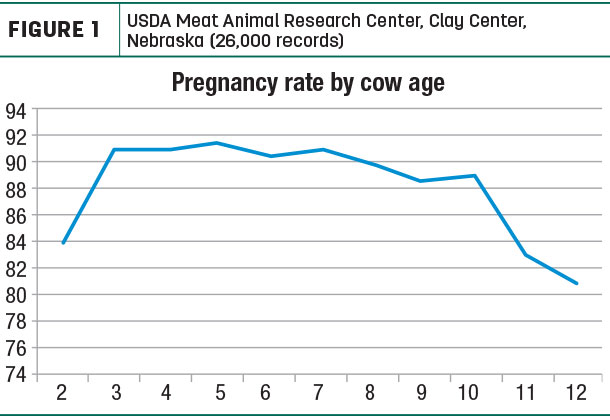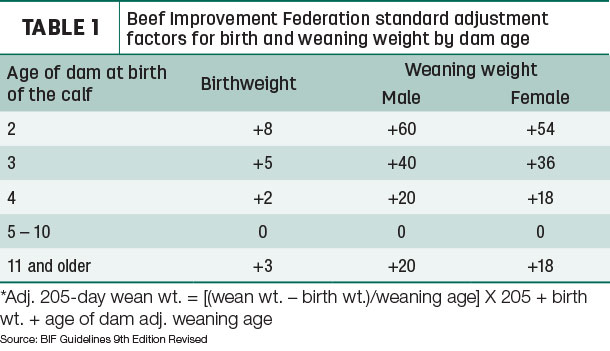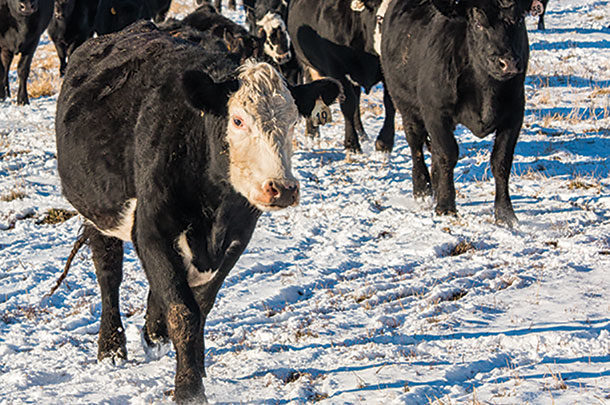This reference data will come in handy in the fall when cows are traditionally kept or culled. Why? As the old saying goes, “You can’t manage what you don’t measure.” Therefore, measuring needs to start at calving season if we are to manage cows in the fall. Cow longevity is one of the most economically important traits in beef cow herds that is also hard to measure.
Year after year, cows need to be evaluated for traits that correlate to longevity; examples include reproductive rate, energy intake and output, and calf raising, to name a few, to truly assess if she is profitable and productive. If she is not productive, then it is time for her to leave the ranch.
Calving performance
Cow productivity can be defined as the ability of a cow to become bred, calve unassisted and raise a calf to weaning with limited inputs each year. Starting this calving season, pay attention to parturition and mothering ability. Did she calve unassisted, claim her calf and respect your territory while the calf was being processed and/or tagged? If the answer to those questions is yes, that’s a good start.
In addition, udder and milk quality should be evaluated. Cows that do not produce milk will likely need to be first on the cull list. In addition, calves that have trouble nursing due to large teats or pendulous udders have reduced performance, and those cows should likely go to market also.
Age
Next, let’s discuss age as it relates to longevity and productivity. As cattle age, productivity should increase from being a heifer to 3 years of age when she is done growing. Between 4 and 8 years of age, cows are highly productive and raise some of the finest calves in the herd. Two datasets from Florida and the USDA Meat Animal Research Center in Clay Center, Nebraska, reveal cows rebreed consistently until age 8. As you can see in Figure 1, by age 10, reproductive performance starts to decline sharply, resulting in a larger percentage of open cows.

Young and old cows will fail to breed each year for a variety of reasons, including fertility and/or hormone imbalance after calving, low or excessive body condition, poor feed quality or health. Older open females have likely paid for themselves through calf sales; however, current body condition may limit her value at market. So when should cows go to town in order to optimize productivity on the ranch but also maintain profit potential at market?
After age 6, beef cattle incisors will begin to show some wear and steadily become more triangular and separated. Depending on the type of forage and environment cattle are raised in, early wear and tear may happen, making it difficult to age some cattle. Therefore, most cattle age 7 and 8 will start to fall into the broken- or smooth-mouth cow category. This can have a stark effect on their profitability at the market, especially if they are also in poor condition.
Data from sale barns in the Upper Midwest, December 2018, show bred cow prices ranging from $800 to $1,800. Peak values were received for young, solid-mouth cows, and price decreased with age and dentition respectively. Consider age dispersion culling to collect some profit from these older cows before they start having problems maintaining body condition or raising a calf.
Be sure to watch seasonal trends in the cattle market, and sell pairs or bred cows when there is demand. This profit could then be used to purchase replacement females, bred heifers or even 3-year-old cows that are already proven productive in raising a calf, rebreeding and are ready to join the mature cow herd.
Weaning performance
Weaning weight of calves is an indication of milk production a dam delivers throughout lactation. Weaning weights have not changed greatly in the last decade despite genetic selection. This may be due to environmental conditions such as pasture and feed quality, making it difficult for cows to supply enough nutrients to calves to reach their weaning potential. If a cow is not weaning calves at 40 to 50 percent (205-day weaning weight; see Table 1) of her mature weight without supplemental feed, she may need to go.
 Comparing weaning weights by cow age group can give an idea if a certain age group is decreasing in performance. Weaning EPDs are adjusted for cows younger than 5 and older than 10 (Table 1). However, if a certain age of cow is not performing to their standards, this may be a signal to send them to market before next year’s calf crop.
Comparing weaning weights by cow age group can give an idea if a certain age group is decreasing in performance. Weaning EPDs are adjusted for cows younger than 5 and older than 10 (Table 1). However, if a certain age of cow is not performing to their standards, this may be a signal to send them to market before next year’s calf crop.
Realizing many commercial producers do not record weaning weights, producers can also compare cows’ size and condition to calf performance. If the cow is overconditioned and her calf is small, she is not likely delivering nutrients to her calf and is overfeeding herself.
Therefore, feed efficiency (input vs. output) is a metric that needs to be evaluated on cow-calf operations to determine which cows are metabolically efficient in their environment. Not all cows are created equal, and keeping cows that thrive on limited feed resources are the genetics that likely will pay you back in the long run.
Lastly, pounds weaned per cow exposed is the best measure of performance in a cow herd, as it takes into account weaning weight and pregnancy rate of the herd. To calculate it, take total pounds of calves weaned divided by total cows exposed during the breeding season. This value will likely be less than average weaning weight, as it takes into account cows that came up open or lost a calf pre-weaning. The best way to improve pounds weaned per cow exposed is to both get more cows pregnant and minimize death loss from birth to weaning.
Summary
Taking the time this calving season to evaluate the past year’s breeding, weaning and calving data will assist operations in making important management decisions. Nonproductive cows should be marketed when there is still some value to them. Ignoring cow depreciation will likely rob profitability from an operation. Thus, keep in mind, marketing cows before they are open or too old to raise a calf will help the operation in the long run. ![]()
PHOTO: A productive cow gets bred every year, calves unassisted and raises a calf to weaning with limited inputs. Photo by Paul Marchant.

-
Taylor Grussing
- Cow-Calf Field Specialist
- South Dakota State University Extension
- Email Taylor Grussing







